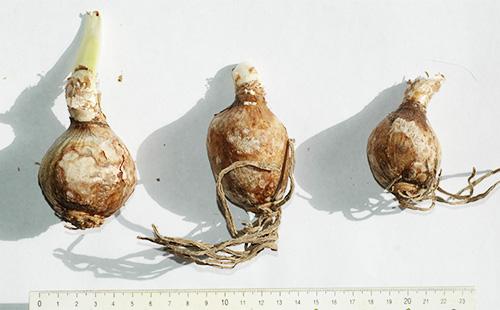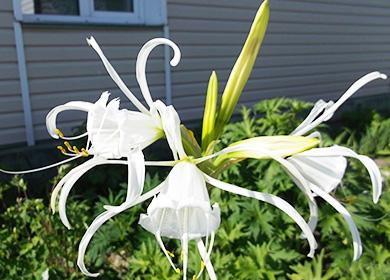The content of the article
Gymenokallis is a bulbous plant with white flowers that have an arachnid appearance. The advantage of spider lily is not only an attractive form, but also a pleasant aroma of vanilla, which creates a cozy "home" atmosphere. The plant is relatively unpretentious in care, can grow at home and outdoors.
Plant description
Gimenocallis was first found in a mountainous area in Peru and Bolivia. It grows in valleys along rivers. The plant belongs to the genus Amaryllis family, grows in the tropics and subtropics, on the hills along the lakes. The place of growth depends on the species, of which there are about 60. The plant came to Europe during the time of great geographical discoveries. The popularity of hymenocallis is not as high as that ofamaryllis, but this will not prevent the flower from becoming a worthy and original decoration of your windowsill.
Most often, Caribbean hymenocallis is grown at home, the main features of which are:
- bulb - pear-shaped or spherical, elongated, having a diameter of up to 10 cm;
- leaves - gray or dark green in color, have a lanceolate pointed shape, length up to 1 m, width - up to 7 cm;
- peduncle - umbrella-shaped, with an inflorescence on top.
The core has the form of an open umbrella, surrounded by six narrow elongated petals. Their length reaches up to 20 cm, the corolla consists of six petals fused together with teeth along the edges. There is also a funnel with stamens with a diameter of about 5 cm.
Flowering occurs in winter, lasts about 100-120 days. Three to 16 buds are located on the peduncle, which open gradually. The flower rises to a height of 50 cm from the middle of the leaf rosette. In other plant varieties, flowering begins in April and ends in August, or lasts from mid-summer to mid-autumn. There are also evergreen varieties. The flowering period ends with the formation of oval-shaped seeds covered with pulp.
The main indoor views
The most common in home floriculture are eight varieties of plants.
- Beautiful. Homeland plants - Caribbean subtropical forests. This species is evergreen, reaches a height of 45 cm, the bulb has the shape of a pear with a diameter of 10 cm. During the season, the plant grows up to eight oval or lanceolate leaves, up to 40 cm long, up to 13 cm wide. Seven to 12 flowers are located on the peduncle , each of which is attached to the peduncle. White flowers looks like an umbrella with elongated petals, smell like a lily.
- Early. It was imported from Peru. Leaves - up to 60 cm, dark green, oblong elongated shape. Flowering occurs in April, ends in mid-summer. The crown is large, well open. The flowers are white, reaching a diameter of up to 10 cm. The plant is popular among gardeners, is considered unpretentious.
- Daffodil. Evergreen culture growing in the coastal areas of Peru. Leaves are dark green, xiphoid in shape. Yellow flowers, with a large crown, almost entirely covered with stamens. Sepals are twice as large as the crown. This type of plant can also be represented by varieties with white and purple flowers. Flowering begins in mid-summer and ends in mid-autumn.
- Broadleaf. It grows in a territory with sandy soil. The plant belongs to grassy. It has elongated leaves up to 70 cm long. The flowers form inflorescences. From a narrow funnel with wavy edges, having a diameter of up to 35 mm, long petals are visible. The stalk reaches a length of 60 cm.
- Caribbean. The culture is evergreen, perennial. The size of the leaves of the lanceolate form reaches 60 cm, the width is about 7 cm. The top has a rounded appearance and a pointed end. Peduncle reaches 60 cm, consists of an inflorescence and eight to ten buds. Flowering occurs throughout the cold season.
- Coastal. At the base there are leaves, the length of which reaches 75 cm. In the middle is a peduncle, consisting of large flowers. Narrow leaves grow to 12-15 cm long, 5-7 mm wide. The crown has smooth, fused edges. Variegate variety of this species is popular among gardeners. A distinctive feature is foliage with yellowish or creamy edges.
- Cordifolia. It differs from other species in long-leafed leaves and an elongated leaf plate similar to a heart. The flowers are white in color, the crown is practically absent, the sepals are small.
- Tubiflora. It grows in Trinidad and South America. The flowers are similar to the Cordifolia variety. Petiole leaves, broadly lanceolate.
Basic care
Despite its exotic nature, the flower is not picky about care. But you should pay attention to some points.
- Lighting. A long and bright light is very important for a flower. In winter, he needs to provide enough sunlight, so additional lighting is needed. If the culture will be indoors, the pot must be placed on windows located in the sunny, southern part. In summer, the flower should be taken out to the balcony or to the garden.
- Temperature. During the period of leaf growth, in summer and spring, the room temperature is suitable for the plant. If there is no additional lighting, the evergreen flower is moved closer to the glass of the window, enclosed by a film to close it from direct sunlight. For the wintering period, the optimal temperature indicators are 14-18 ° C. If additional lighting is used, it is not necessary to lower the temperature. When a deciduous variety is grown, it is necessary to collect the bulbs and dry them. Then store in a cool place at a temperature of 10-12˚С.
- Watering. This crop does not like severe dry soil. With a lack of moisture, the leaves begin to fade, lose their saturated color. Excessive watering can lead to rotting of the root system and bulb. Soil moisture should be optimal. In winter, watering is reduced. Along with watering, it is recommended to wipe the leaves with a damp cloth.
- Air humidity. Foliage can be rinsed periodically under warm water. At this point, you need to close the buds and flowers from the spray. You can learn about the lack of moisture by the condition of the leaves - they begin to dry out. If there is a lot of moisture, yellow spots appear.

Transfer
The plant grows best in loose soil with an acidity index of 5.0-6.0 pH. The most commonly used mixture is:
- peat;
- coarse river sand;
- humus;
- turf;
- sheet earth.
The proportion of the mixture is 1: 1: 2: 2: 2. A simple mixture of sheet and turf soil, coarse sand in a ratio of 3: 1: 1 is also suitable. You can plant the bulbs in a special soil for bulbs with the addition of coal (wood). The pot must be large so that a well-developed root system fits. The bottom of the pot should be covered with a drainage layer (best of expanded clay). This will help to avoid stagnation of water.
When planting, the bulb is placed at a height at which it will protrude about one third above the ground surface. The flower needs to provide good access to the sun.
Pot growing
Planting can be done in pots or in open ground. When growing in a pot, it is important to remember the following conditions:
- in the fall - you need to reduce watering, reducing it to a minimum, otherwise the bulb will rot and die;
- after falling leaves - the pot is placed for three months in a dark place with minimal humidity at a temperature of 11-12 ° C;
- during rest - watering is not carried out, monitoring of containers is carried out so that mold does not appear;
- during awakening - (February 20th) they put the pot in the light and begin to water it a little.
Within a month after waking up, the first leaves appear.
Outdoor cultivation
When planting in the soil, the bulb is first germinated in a glass with peat, wood shavings. A layer of soil 5 cm high is poured on top of the onion, the kidneys appear three weeks later. There should be small openings in the glass so that there is a good outflow of water. Landing should be started from the first of May. With the onset of late autumn, the bulbs are dug up and stored in a cool, dry place.
Breeding methods
Bulbs are more prone to germination than seeds. They can rise within three weeks to two months. Young shoots should be well lit and watered. The soil should not be dry. In strong sunlight, the flower must be rearranged in the penumbral zone so that it does not receive a burn.
Bulbs are the best plant propagation option. In a flower at the age of three, in addition to the main bulb, several small ones appear. The children are separated and seated in a pot with moistened soil. When the plant becomes stronger, it can be transplanted into the open ground.
Fertilizer application
At the time of flowering, mineral fertilizers are needed. During the rest period, you need to fertilize the flower no more than once a month. Organic fertilizing with humus and manure is not suitable for him. It is necessary to avoid fertilizers with nitrogen, which slow down the formation of buds, can provoke rotting of the stems.
With enhanced growth, top dressing is performed once every two to three weeks. Suitable liquid fertilizers for bulb and flowering plants. In winter, you do not need to feed.

Diseases and Pests
The culture loves moist soil, therefore it is invaded by various parasites, which must be removed with the help of insecticides. Most often, the plant is affected by pests such as:
- spider mite;
- aphid;
- thrips.
When these insects are found, tools such as Fitoverm and Actellik are used.
Also, a flower can undergo various diseases. The main ones are red burn (stagonosporosis) and gray rot. To avoid the development of diseases, you need to inspect the bulb well at the time of transplantation. If defects are found, they must be cut and greased with grated charcoal. This option is effective for minor lesions. If rot spread to the entire bulb, it will not be possible to save it. The cause of the disease most often is a strong soil moisture.
If brown spots with black spots appear on the leaves, anthracnosis may be affected. To get rid of such problems, you need:
- cut off the affected leaves;
- spray the culture with fungicide;
- reduce watering.
Gymenokallis is a very unusual plant, which can become a worthy decoration of a flower bed or window sill. If its leaves begin to turn pale, watering should be improved. When black dots appear on the surface of flowers, you need to pay attention to temperature indicators and air humidity. With excessive lighting, yellow blotches appear on the leaves of the plant. The flower turns yellow when damp, and due to a lack of heat often ceases to bloom.

